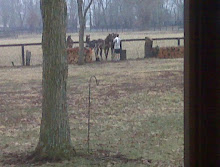
Pedigree, conformation, biomechanics, heart score, etc. are facts and figures put on paper meant to predict future thoroughbred performance.
But races are run on the track, not on paper.
The real magic takes place when a horse is moving.
Traditional means of evaluating yearlings has been limited to measurements/observations taken at rest – and therefore miss a very important piece of the puzzle.
Luckily, the recent economic downturn has made consignors much more willing to allow access to behind-the-scenes information in an effort to sell their stock.
Physiological testing of yearlings provides you with an inside glimpse of how efficiently all of the horse’s systems work together during the stresses of actual exercise.
No longer do you have to rely on assessing potential, now you can select based on actual performance during the pre-sales conditioning regimen.
I will have this data on over 100 yearlings being prepped for the Saratoga Select Yearling Sale this fall.
For instance, V200 is the velocity/speed achieved at a heart rate of 200bpm (beats per minute) and is indicative of the aerobic capacity of the thoroughbred.
This aerobic capacity is a measurement of the horse’s ability to utilize oxygen to fuel the demands of exercise, higher speeds at V200 will lead to better racing performance.
Research has given us the following values for V200 in thoroughbreds:
• V200 range for foals at 6 months of age:
8.51mph to 11.93mph
• V200 range for yearlings:
9.94mph to 13.24mph
• V200 range at start of 2nd year:
11.93mph to 14.91mph
How do your prospects match up?
Which grow strongest during the pre-sales training regimens?
Whether you are a buyer or a seller, this data can help you to dramatically increase your Return on Investment.
More information online at www.thoroedge.com/yearling_selection
Bill Pressey
ThoroEdge Equine Performance
Louisville/Lexington, KY USA
502-541-5087
bill@thoroedge.com
“Measuring performance, not merely potential.”
But races are run on the track, not on paper.
The real magic takes place when a horse is moving.
Traditional means of evaluating yearlings has been limited to measurements/observations taken at rest – and therefore miss a very important piece of the puzzle.
Luckily, the recent economic downturn has made consignors much more willing to allow access to behind-the-scenes information in an effort to sell their stock.
Physiological testing of yearlings provides you with an inside glimpse of how efficiently all of the horse’s systems work together during the stresses of actual exercise.
No longer do you have to rely on assessing potential, now you can select based on actual performance during the pre-sales conditioning regimen.
I will have this data on over 100 yearlings being prepped for the Saratoga Select Yearling Sale this fall.
For instance, V200 is the velocity/speed achieved at a heart rate of 200bpm (beats per minute) and is indicative of the aerobic capacity of the thoroughbred.
This aerobic capacity is a measurement of the horse’s ability to utilize oxygen to fuel the demands of exercise, higher speeds at V200 will lead to better racing performance.
Research has given us the following values for V200 in thoroughbreds:
• V200 range for foals at 6 months of age:
8.51mph to 11.93mph
• V200 range for yearlings:
9.94mph to 13.24mph
• V200 range at start of 2nd year:
11.93mph to 14.91mph
How do your prospects match up?
Which grow strongest during the pre-sales training regimens?
Whether you are a buyer or a seller, this data can help you to dramatically increase your Return on Investment.
More information online at www.thoroedge.com/yearling_selection
Bill Pressey
ThoroEdge Equine Performance
Louisville/Lexington, KY USA
502-541-5087
bill@thoroedge.com
“Measuring performance, not merely potential.”




No comments:
Post a Comment